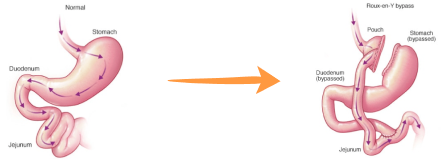- Anesthesia:
The patient is given general anesthesia, which puts them to sleep and ensures they do not feel any pain
during the
surgery. - Incision:
The surgeon makes several small incisions in the abdomen and inserts a laparoscope, a thin tube with a
camera and light
on the end, to view the surgical area. - Stapling:
The surgeon uses a stapling device to create a small pouch at the top of the stomach, which will serve
as the new
stomach. - Bypass:
The surgeon then cuts the small intestine and attaches one end to the new stomach pouch, creating a
bypass for food to
pass through. - Reattachment:
The other end of the small intestine is reattached to the lower portion of the intestine, allowing
digestive juices to
mix with food further down the digestive tract. - Closure:
The incisions are closed with sutures or surgical staples.
Roux-en-y Gastrectomy surgery Benefits
Roux-en-Y gastrectomy, also known as gastric bypass surgery, is a type of weight loss surgery that involves dividing the
stomach into two parts and rerouting the small intestine to a new connection with the smaller stomach pouch. Here are
some of the benefits of Roux-en-Y gastrectomy:
- Body mass index (BMI):
Roux-en-Y gastrectomy is typically recommended for individuals with a body mass index (BMI) of 40 or higher, or a BMI of
35-39.9 with obesity-related health problems such as diabetes, high blood pressure, or sleep apnea. - Significant weight loss:
Roux-en-Y gastrectomy can result in significant weight loss, with most patients losing 50-80% of their excess weight
within the first two years after the surgery. - Reduced risk of certain cancers:
Roux-en-Y gastrectomy may also reduce the risk of certain cancers, such as breast and colon cancer. - Increased lifespan:
Roux-en-Y gastrectomy has been shown to increase lifespan in some individuals, particularly those with obesity-related
health problems. - Improved quality of life:
Roux-en-Y gastrectomy can improve overall quality of life, including physical health, mental health, and social
functioning.

Roux-en-y Gastrectomy Procedure
Roux-en-Y gastrectomy, also known as gastric bypass surgery, is a major surgical procedure that involves
several steps.

The surgery typically takes 2-4 hours to complete and requires a hospital stay of 2-3 days. After the
surgery, patients
will need to follow a strict diet and exercise plan to ensure proper healing and long-term weight loss success.
Frequently asked questions
Roux-en-Y gastric bypass (RYGB) is a weight loss surgery that involves creating a small stomach pouch and rerouting the small intestine to this pouch, patients can expect to lose between 60% to 80% of their excess weight within the first year after surgery.
Roux-en-Y gastric bypass (RYGB) is a surgical procedure that involves creating a small stomach pouch and rerouting the small intestine to this pouch, which limits the amount of food that can be eaten and reduces the absorption of calories.
Recovery from Roux-en-Y gastric bypass (RYGB) surgery can vary from patient to patient, but most people can expect to spend several weeks to a few months recovering from the procedure.
Take charge of your health today. Schedule an appointment.
BOOK A SITTING
